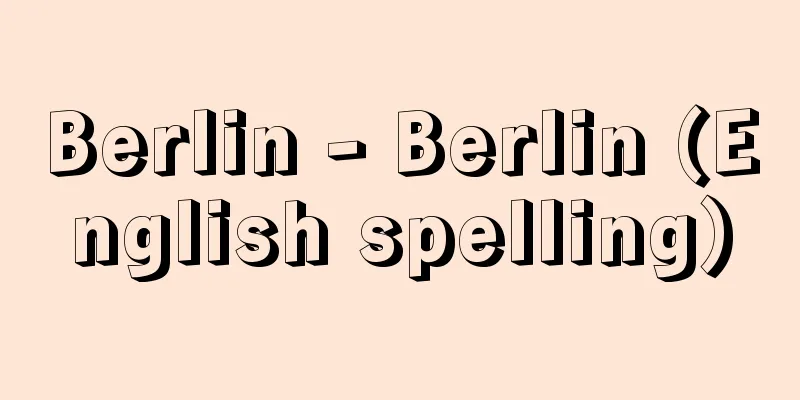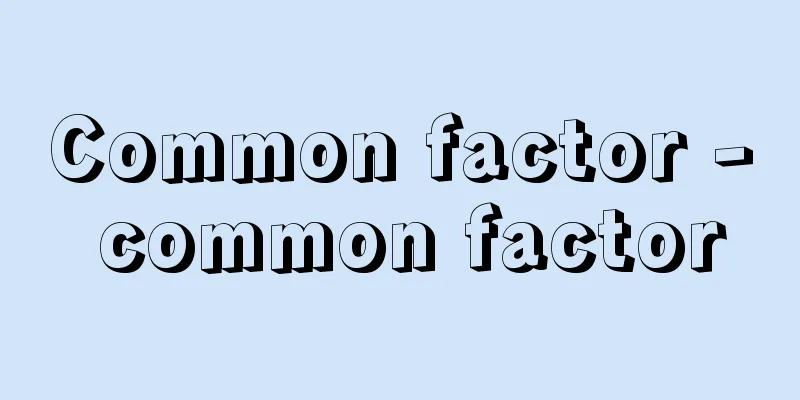Berlin - Berlin (English spelling)

|
The capital of the Federal Republic of Germany and the largest city in the country. It has an area of 883 square kilometers (480 square kilometers of which are in the former West Berlin and 403 square kilometers in the former East Berlin). It has a population of 3,382,200, with a ratio of 6 in West Berlin to 4 in East Berlin (2000). In 2002, the population was 3,392,400. About 12% of the population, or 420,000, are foreigners, of whom 83% live in West Berlin and 17% live in East Berlin. [Hiroshi Sasaki] OverviewThe Berlin Wall, which was built on August 13, 1961 and was a symbol of the division between East and West Germany, collapsed after 29 years on November 9, 1989, which led to the unification of Germany on October 3, 1990. With the unification of Germany, East and West Berlin became one city, but there was a long debate about moving the capital of unified Germany from Bonn, the capital of the former West Germany (Federal Republic of Germany), to Berlin, and in June 1991, the Bundestag reaffirmed the move to Berlin by a margin of just 17 votes (337 in favor of moving to Berlin, 320 in favor of remaining in Bonn). In 1993, it was also decided that the deadline for the relocation would be the year 2000. Of the 22,000 federal civil servants working in Bonn at the time of the decision to move to Berlin in 1991, 7,300 moved to Berlin, and all 4,500 employees of the Bundestag moved to Berlin. The 14 federal institutions that moved to Berlin were the Presidential Office, the Bundestag, the Bundesrat, the Chancellery, the Press and Information Agency, the Ministry of Foreign Affairs, the Ministry of Finance, the Ministry of the Interior, the Ministry of Justice, the Ministry of Economics and Technology, the Ministry of Transport and Construction, the Ministry of Labor and Social Affairs, the Ministry of Family Affairs, and the Ministry of Women and Youth. The six ministries that remained in Bonn were the Ministry of Defense, the Ministry of Health, the Ministry of Food and Agriculture, the Ministry of Economic Cooperation, the Ministry of the Environment, and the Ministry of Education and Research, each of which had a branch office in Berlin. From the spring to the end of 1999, the main government offices were relocated using the buildings of the former East German government, and the new capital began to function. The new government district is being constructed on the part of the Spree River (Spreebogen) that curves northward in the first district of Berlin, based on a design by Dresden-based architect Axel Shultes, who was selected as the result of an international competition. This is based on the idea of the Mall in Washington. The Diet building that occupies this corner is a renovated version of the former Imperial Diet Building, and was completed in April 1999. Immediately after unification, some people saw the decision to make Berlin the capital of a unified Germany as going against the times, but with the realization of the accession of the Visegrad Group of Four countries (Hungary, Slovakia, Czech Republic, and Poland) and the Central European Free Trade Agreement (CEFTA) member states (Hungary, Slovenia, Slovakia, Czech Republic, and Poland) to the EU, it can be said that this decision was ahead of its time. In addition, anticipating the great development of the capital Berlin, the city of Berlin and the state of Brandenburg had agreed to a merger, but this was rejected in a referendum in May 1996. The city of Berlin was in favor of the merger by 54% to 46%, while the state of Brandenburg was opposed by 37% to 63%. The background to this result was that people feared that the state of Brandenburg, with a population of 2.54 million (1995), would be swallowed up by the huge Berlin, and they did not want any sudden changes. [Hiroshi Sasaki] Nature and urban developmentThe city is located in the eastern part of the North German lowlands, on the west side of the Oder-Neisse River, in the wide lowlands called the "Warsaw-Berlin Progenitor Valley." The city straddles the Barnim Plateau to the north and the Teltow Plateau to the south. The Spree River, which flows through this progenitor valley, runs through the city from east to west, and joins the Havel River, which flows north to south at the western edge of the city. The basins of both rivers are dotted with large and small lakes, and many place names end with "dam," which means a dam on a lake, as seen in the name of the busy shopping street Kurfürstendamm. The highest point is 115 meters on the Müggelberg in the east of Berlin. Other hilly areas include Schöneberg (103 meters), Havelberg (97 meters), and Kreuzberg (66 meters). These are moraine hills left by continental glaciers in the Pleistocene (Pleistocene) epoch. The Teufelsberg (115 metres) in west Berlin is an artificial mountain made up of rubble from buildings destroyed during World War II. Located at 52°31' north latitude and 13°25' east longitude, Berlin has a strong inland climate. The average temperature is 18.7°C in the warmest month (July) and -0.2°C in the coldest month (January), with a large annual range of 18.9°C. The annual precipitation is 589.4 mm. The water surface freezes for 40 days a year, making winters much colder than Emden on Germany's north coast, where it freezes for only 5 days. However, the air in May is refreshing, and the comfort of clear, sunny days is well known as the "Berlin air." The city is divided into three areas: (1) the City in the center of the city, (2) the Wilhelminian Ring, an inner residential area surrounding the City with a width of about 5 kilometers, and (3) the Outer Ring extending beyond that. (1) The City was the area of the city in 1825 when it was the capital of Prussia, and roughly corresponds to Berlin's first district, the Mitte (center). It is the city area on both the north and south sides of the route from the Brandenburg Gate, which was on the border between East and West Berlin, to Alexanderplatz in the east, passing through Unter den Linden, the old center of Berlin, Marx Engelsplatz, Rathausstrasse. Friedrichstrasse, which runs north and south, was given a new look as the center of the new capital, and became a shopping street on par with Kurfürstendamm (Kudamm) on the West Berlin side. As the city's functions increased, the population of the City began to decline, reaching 296,000 in 1925, 264,000 in 1939, 125,000 in 1946 after the war, and 91,000 in 1963. The declining population moved to the outskirts of the city, resulting in the so-called "doughnut phenomenon." The city center has created a mixed urban landscape where modern buildings and renovated residential apartments from the socialist era coexist, creating a culturally unique urban landscape that showcases Berlin's history. (2) The Wilhelm Ring District is a city area formed during the reign of Wilhelm II (reigned 1888-1918). It is characterized by the fact that roads radiate out from the ring road, which was built by removing the old city wall, to remote areas. This is the most densely populated area, and includes the six former districts of Berlin excluding Mitte, as well as Schöneberg, Wilmersdorf, Charlottenburg, etc. The western part is a residential area favored by wealthy citizens. (3) The outer district corresponds to the outer edge of "Greater Berlin," which was established in 1920 after the city expanded further outward since the end of the 19th century under the slogan "Into the Green." Multi-storey buildings are lined up along the radial roads, among which are scattered urban facilities such as cemeteries, sports fields, and Schrebergarten (small farms). Residential areas such as Konradshöhe in the northwest, Tegelort, and Karolinenhof in the southeast are located near the surrounding lakes, while Grünewald in the west and Frohnau in the north spread out in the forest. In addition, industrial districts such as Siemensstadt, Tegel, Schöneweide, and Marienfelde have also been established. Grünewald is also a popular day trip destination for city residents. [Hiroshi Sasaki] The division of East and West Berlin - the Berlin WallAfter World War II, Berlin was occupied by the United States, the United Kingdom, France, and the former Soviet Union, and divided into the eastern part (East Berlin) under the control of the Soviet Union and the western part (West Berlin) under the control of the three countries excluding the Soviet Union. East Berlin was declared the capital of the German Democratic Republic (East Germany) when it was founded in October 1949. West Berlin was given a status equivalent to that of a state of the Federal Republic of Germany (West Germany) by the 1949 "Basic Law" (Constitution of the Federal Republic of Germany) and the 1950 "Berlin Charter". After the war, West Berlin became an "island" left behind in East German territory, and during the "Berlin Blockade" by the Soviet Union from June 1948 to May 1949, the US Air Force supplied supplies by air. In August 1961, East Germany built the so-called "Berlin Wall" on the border between East and West Berlin, blocking the movement of residents between East and West Berlin. After that, the Four-Power Agreement of 1971 and various other agreements between East and West Germany allowed political, economic and social ties between West Berlin and West Germany, transport links by rail, road, water and air, visits by West Berliners to East Berlin, and telephone communication between East and West Berlin. In 1987, the 750th anniversary of the city's founding was celebrated in East and West Berlin, with a variety of commemorative events, monuments and urban development projects being carried out in both cities. However, two years later, in the summer of 1989, 126,000 East Germans fled to the West German embassy in Prague, and several thousand fled to Austria via Hungary. On November 6 of that year, 500,000 people participated in a demonstration in Leipzig. The East German leaders resigned, and on November 9, amid rapid democratization, the "Berlin Wall," which had stood for 29 years, finally collapsed. [Hiroshi Sasaki] industryIn 1936, the number of employees by industrial sector was first in the electrical industry, which accounted for 49.8% of Germany's total, and also ranked first in terms of production value, at 48.3%. World-famous electrical industry companies such as Siemens and AEG were based in Berlin. Second was the clothing industry, with 22.7% of employees and 35.6% of production value. Third was printing, and fourth was the mechanical engineering industry, with these top four sectors accounting for a combined total of 300,000 employees, or 53% of all industrial employees in Berlin. In the service sector, civil servants accounted for 10.8% of Germany's total between the First and Second World Wars, the cultural and educational sectors for 15.5%, insurance for 19.7%, and finance for 20.4%. In 1939, 6.3% of the total German population lived in Berlin, and the production income of the service sector and that of industry were almost equal. In 1995, Berlin's total production was 147.8 billion German marks (DM) (approximately 11 trillion yen), of which 35% was the service industry, 21% industry, and 19% public and non-profit organizations. Since unification, industry has faced a serious crisis in both West Berlin, which had been blessed with various tax and other preferential treatment, and East Berlin, which had been supported by national policy as the capital of East Germany. On the other hand, the service sector has been growing steadily due to liberalization and the relocation of the capital. Since German unification, the number of employed people in Berlin has been decreasing every year, but it increased by 0.5% for the first time in 2000, when the capital was relocated. Of the 1.54 million employed people, the largest sector is the service sector, with 1.24 million (80.8%, of which 159,000 are public services, about 10% of the total), 180,000 (11.7%) in manufacturing, and there are still 7,700 people working in agriculture. The unemployment rate in Berlin is very high at 15%, while the unemployment rate in Germany as a whole is in the 9% range, reflecting the stagnation of the economy, just like in the former East German states. Incidentally, the states with the highest unemployment rates are Saxony-Anhalt at 20.2%, Mecklenburg-Vorpommern at 18.8%, Brandenburg at 17.9%, and Saxony at 17.6%, while the lowest is Baden-Württemberg at 4.9%. The number of industrial employees is greatest in the electrical industry, followed by food and tobacco, machinery, and publishing and printing. The electrical industry, which accounted for 52% of the German Empire's total during Berlin's "Golden Twenties," and the monopoly held by Berlin's nine major banks, which held 49% of deposits, have long since been lost. However, the potential for scientific research that dates back to the days of East Berlin is great, and the city is pursuing an industrial revival policy by establishing the Berlin-Adlershof Science and Industry Park (WISTA), its management organization WISTA Management GmbH, and the Technology Entrepreneurs Center to foster venture businesses, in order to promote high-added-value high-tech industrialization. Due to Berlin's geographical location and the legacy of its socialist era, Berlin companies have strong ties with former socialist countries. Poland is particularly close by, and Berlin is committed to economic cooperation with Poland and the education and guidance of its industrialists and entrepreneurs. [Hiroshi Sasaki] Regional PlanningAt Messegeland in the west of the city, various trade fairs (a word derived from the church mass, and which is extended to mean a market) and cultural events are held, which are factors that attract many visitors from inside and outside of Berlin. There are 17 universities, of which four are comprehensive universities: Humboldt University (formerly the University of Berlin), Free University (founded in West Berlin after World War II with a donation from the United States), Technical University (formerly the Technical University of Charlottenburg), and the European School of Economics (private). The airport, Tempelhof Airport, which was active during the Berlin Blockade, was small and became a local airport, and Tegel Airport took its place as the main entrance to West Berlin. However, with the current number of passengers, which is 25 million per year, expected to increase to 45 million in the future, it was decided in 1996 that Schönefeld Airport, which is adjacent to the southeast of Berlin and is the main entrance to the former East Germany, would be the only international airport, and construction began. The railway network has been developed to the Ruhr area and Munich, and in 1998 construction of a Shinkansen line between Berlin and Hamburg began. In addition, since 1992, population outflow has begun, and the city has escaped from being an "isolated island" and has begun to suburbanize urban functions like other major cities around the world. Accordingly, suburban trains have been expanded and developed to a 50-kilometer radius. Surrounding Leipzig Square to the south of the Brandenburg Gate is redevelopment being carried out by international companies such as Mercedes-Benz, ABB (Asia Brown Boveri, Europe's largest heavy industrial company based in Switzerland), Sony Europe, and Hertie (department store). To the east, the federal republics, such as the Saxony Hall, the Hessen Hall, and the Rhineland-Palatinate Hall, are building new embassies, giving a sense of the new capital city. [Hiroshi Sasaki] historyFoundations of DevelopmentThe Slavic Wendish people had been living in present-day Berlin and its surrounding areas since the Migration Period, but around 1160 Albrecht der Bär (c. 1100-1170), Margrave of Brandenburg from the Askaniel family, pacified the Wendish people and began German settlement in the area. A merchant's base was established on an island in the middle of the Spree River, a key transportation route, and this settlement obtained city rights around 1230 and was called Cologne. Berlin was then built on the right bank. Cologne first appears in historical documents in 1237, and Berlin in 1244. These two cities became the foundations of the later great city of Berlin. The cities of Berlin and Cologne, connected by a water mill dam, developed rapidly under the protection of the margrave and the geographical advantages for transportation and commerce. In 1307, they were administratively united as the city of Berlin and Cologne under a common city council. In 1320, the Askaniel family was extinguished, and the margrave's power weakened for a century, but during that time the united city of Berlin and Cologne developed on its own as an autonomous city, and in the mid-14th century it joined the Hanseatic League and became the central city of Brandenburg, where the feudal assemblies were held. However, after Frederick of the Hohenzollern family was appointed margrave of Brandenburg in 1415, the balance of power with the monarchical power was reversed, and under the next king, Frederick II, Berlin and Cologne were stripped of their privileges as autonomous cities and were once again separated and placed under the administration of the monarch. [Eihachiro Sakai] As a royal palace and government cityAfter that, the status of both cities as commercial cities declined, but on the other hand, the construction of the Hohenzollern residence in the north of Cologne (construction began in 1443, permanent residence after 1486) led to the development of both cities as royal palaces and government offices. In 1539, the Reformation took place and the cities became Protestant. During the Thirty Years' War, both cities suffered heavy damage (300 out of 845 houses in Berlin and 150 out of 364 in Cologne were destroyed. At the end of the war, the combined population of both cities was about 6,000), but under Elector Friedrich William, new foundations were laid for the development of both cities. A common wall was built around Berlin and Cologne (1658-1683), which also enclosed the third city, Friedrichswerder, on the left bank of the Spree. Around the same time, the fourth city, Dorotheenstadt, and the fifth city, Friedrichstadt, were established outside the castle on the left bank. Many Protestants (Huguenots) immigrated from France to Friedrichswerder and Dorotheenstadt, and they made a great contribution to the development of Berlin's commerce and industry. Furthermore, with the construction of a canal connecting the Oder and Spree rivers (1662-1668), Berlin became an important hub city on the commercial waterway connecting Hamburg and Breslau (Wrocław). Then, under the rule of the next king, Frederick I, who became the first Prussian king in 1701, the five cities of Berlin, Cologne, and the three new cities mentioned above were united in 1709 to form Berlin, the capital of the Kingdom of Prussia. The population at that time, including the military, was 56,600. [Eihachiro Sakai] Prussian capitalIn the 18th century, Berlin developed into one of the major cities in Europe under Frederick William I and Frederick II. As the capital of Prussia, where the military was the backbone of the country, it was a city with a strong military influence. In 1725, there were 12,000 soldiers out of a population of 60,000, meaning that one in five people was a soldier. On the other hand, thanks to the king's mercantilist industrial promotion policy, the cotton and silk textile industries flourished in Berlin, and the state-run porcelain factory, established in 1763, also played an important economic role. By 1800, the population had increased to 172,000. During this time, the city was developed, and on both sides of the boulevard Unter den Linden, opened by the Elector in 1647, the Armoury (completed in 1706), the Crown Prince's Palace (1732), the Princess's Palace (1737), the Royal Opera House (opened in 1742), the Royal Library (1780), and other impressive buildings stood side by side. After Prussia was defeated by France in 1806, Berlin was occupied by French troops for two years. However, the Prussian Reforms, which were implemented to rebuild the Prussian state, breathed new life into Berlin. The City Ordinance (1808) gave Berliners the right to self-government based on the system of a city council and a council. The founding of the University of Berlin (1810) enhanced Berlin's status as a cultural city. The abolition of the zunft (professional guilds) (1810) and the abolition of internal customs duties (1818) revitalized Berlin's commerce and industry, and in the 19th century Berlin developed into an important industrial city in the fields of ready-made clothing, furniture, machinery, and electrical machinery. Companies founded here include Borsig (1837), Siemens (1847), and AEG (1883). After the railway line opened between Berlin and Potsdam in 1838, Berlin occupied a central position in the North German railway network. Meanwhile, the industrialization of Berlin gave birth to a proletariat class in the area, and this social problem combined with the citizens' political movements to cause a revolution in Berlin in March 1848. The citizens were victorious in the street fighting on March 18-19, and the Prussian National Assembly convened in Berlin in May to deliberate a constitution, but reactionary forces rose to power in the autumn, and the revolution ended without bearing fruit. [Eihachiro Sakai] German Imperial CapitalWith the establishment of the German Empire in 1871, Berlin became the capital of the new empire. The population, which was 548,000 in 1861, reached 1,325,000 in 1880, making it the first city in Germany to reach one million people. Wilhelmstrasse became the nickname of the imperial government district, and a diplomatic district with embassies from various countries appeared on the southern edge of the Tiergarten. Wealthy citizens built their homes in the western suburbs, while workers' districts with densely packed unsanitary tenements were created in the eastern and northern suburbs. In 1900, about half of Berlin's 2.7 million residents lived in tenements. Berlin became the center of the socialist movement, and after Berlin's defeat in World War I, it was again the stage for revolution in November 1918, but the victors were the Social Democratic government, which thoroughly suppressed the radicals. In 1920, Berlin, including the surrounding seven cities, 59 villages, and 29 knight farms, became "Greater Berlin" with an area of 87,810 hectares. In the 1920s, when Germany was facing political and economic crisis, Berlin enjoyed its cultural "Golden Twenties". During this period, Berlin led the world in music, theater, painting, literature, and also in popular culture such as film and cabaret. However, this ended with Hitler's rise to power. Berlin attracted the attention of the world with the 1936 Berlin Olympics, celebrated the 700th anniversary of the city's founding in 1937, and in 1943, its population reached an all-time high of 4,489,700. However, the city center was reduced to ruins by air raids during World War II and fierce street fighting from April 23 to May 2, 1945 at the end of the war. 20% of the city's houses were destroyed, 50% were damaged, and the population fell to 2.8 million. [Eihachiro Sakai] After World War IIAfter the war, Berlin came under the joint administration of the Allied Powers, and like the rest of Germany, it was divided into four occupation zones: the United States, the United Kingdom, France, and the former Soviet Union. However, a unified city council existed under the Allied Control Council, and city council elections were held. However, due to the intensification of East-West conflict, the joint administration of the Allied Powers ceased to function after June 1948, and during the Soviet blockade of Berlin (June 1948-May 1949), the city council and council that were originally located in the Soviet zone were transferred to the Western zone in September 1948, while in November of the same year, the Soviet zone created its own council, and Berlin's city administration was divided into East and West. With the establishment of the Federal Republic of Germany (West Germany) and the German Democratic Republic (East Germany) in 1949, West Berlin was conditionally incorporated into the Federal Republic, and East Berlin became the capital of the Democratic Republic. With the unification of East and West Germany in 1990, Berlin became the capital of the Federal Republic of Germany. [Eihachiro Sakai] World Heritage RegistrationIn Berlin, the Palaces and Parks of Potsdam and Berlin (1990, 1992-1999, Cultural Heritage), the Museum Island in Berlin (1999, Cultural Heritage), and the Modern Housing Estates of Berlin (2008, Cultural Heritage) have been registered as World Heritage Sites by UNESCO (United Nations Educational, Scientific and Cultural Organization). [Editorial Department] "Contemporary History of Berlin" by Nagai Kiyohiko (1984, Asahi Sensho) ▽ "Die Mauer - The Berlin Wall 1981-1991" by Hashiguchi Joji (1991, Information Center Publishing Bureau) ▽ "Berlin, City of the Future - Vision of Berlin in 2000" edited by Kimura Naoji (1995, Toyo Publishing) ▽ "The Road to Europe-Germany" edited by Sakai Eihachiro and Hosaka Kazuo (1996, University of Tokyo Press) ▽ "Berlin - Past, Present and Future" edited by Kido Eiichi, Komatsu Keiichi and others (1998, San-ichi Shobo) ▽ " Return to Berlin - Diary of Germany in 1997" by Brigitte Sozee, translated by Ukyo Yozo (1999, Mainichi Shimbun) ▽ "Illustrated Berlin" written by Tani Katsuji, photographed by Takano Akira and Takeda Kazuhide (2000, Kawade Shobo Shinsha) ▽ "The Berlin Wall Collapses: A Changing Europe" by Shunji Sasamoto (Iwanami Shinsho) "Berlin: A City Evolves" by Shunta Sugimoto (Kodansha Gendai Shinsho) [References] | | | | | | | | | | | | | |Prussian | | |Unter den Linden street in the old center of Berlin. It leads to the Brandenburg Gate. In the center of the photo is the Berlin Cathedral on Museum Island. Germany Berlin ©Shogakukan "> Berlin city This is a renovated version of the former German Reichstag building. It was completed in April 1999. It is located in the 1st district of Berlin. Germany Berlin ©Shogakukan "> Parliament Building (Germany) Part of the Berlin Wall remains on Niederkirchner Strasse, south of Potsdamer Platz. Berlin, Germany ©Masashi Tanaka "> Berlin Wall One of the symbolic buildings of the division of East and West Germany, located on the western edge of Berlin's Mitte (center) district. 26m high, 65.5m wide, 11m deep. The photo shows the east side. Berlin, Germany ©Masashi Tanaka "> Brandenburg Gate Source: Shogakukan Encyclopedia Nipponica About Encyclopedia Nipponica Information | Legend |
|
ドイツ連邦共和国の首都で、国内最大の都市。面積883平方キロメートル(うち旧西ベルリン側480平方キロメートル、旧東ベルリン側403平方キロメートル)。人口338万2200で、西ベルリン側6に対して東ベルリン側4という比率となっている(2000)。2002年の人口は339万2400。人口の約12%、42万が外国人で、うち83%は西ベルリン側に、17%は東ベルリン側に住んでいる。 [佐々木博] 概容1961年8月13日に構築され、東西ドイツ分裂の象徴であった「ベルリンの壁」は、1989年11月9日、29年目にして崩壊し、1990年10月3日のドイツ統一への契機となった。ドイツ統一に伴って東西ベルリンも一つの都市となったが、統一ドイツの首都を旧西ドイツ(ドイツ連邦共和国)の首都ボンからベルリンへ移転するについては長い間論議され、1991年6月、連邦議会はわずか17票差(ベルリン移転賛成337票、ボン残留賛成320票)でベルリンへの移転を再確認した。また1993年には移転の期限を2000年とすることが決定された。 ベルリン移転が決まった1991年の時点でボンで働いていた連邦公務員2万2000人のうち、ベルリンへ移るのは7300人、連邦議会の4500人の職員はすべてベルリンへ移動することとなった。ベルリンへ移動する連邦機関は、大統領府、議会、連邦参議院、首相府、新聞情報庁、外務省、財務省、内務省、法務省、経済技術省、運輸・建設省、労働社会省、家庭省、婦人青年省の14機関、ボンに残留する機関は、国防省、健康省、食糧農林省、経済協力省、環境省、教育研究省の6省で、ベルリンにそれぞれ出先機関を置く。1999年の春から年末にかけて、旧東ドイツ政府の建物を利用して主要官庁が移転し、新首都として機能し始めた。なお新しい官庁街は、ベルリン1区の、北に向かって湾曲したシュプレー川の一部(シュプレーボーゲン)に、国際コンテストの結果決まったドレスデン在住の建築家アクセル・シュルテスAxel Shultesの設計によって建設がすすめられている。これはワシントンの「モール」のアイデアを生かしている。この一角を占める議事堂は旧帝国議会議事堂を改修したもので、1999年4月に完成した。 ベルリンを統一ドイツの首都にするにあたっては、統一直後、時代に逆行するとの見方もあったが、ビシェグラード四国(ハンガリー、スロバキア、チェコ、ポーランド)や中欧自由貿易協定(CEFTA=Central European Free Trade Agreement)参加国(ハンガリー、スロベニア、スロバキア、チェコ、ポーランド)のEU(ヨーロッパ連合)への加盟が実現するに至って、時代を先取りした決定であったといえる。また、首都ベルリンの大発展を予想して、ベルリン市とブランデンブルク州は合併に合意していたが、1996年5月の国民投票で否決された。ベルリン市は54%対46%で合併に賛成であったが、ブランデンブルク州は37%対63%で反対が多かった。この結果の背景には、人々が巨大なベルリンに人口254万(1995)のブランデンブルク州が飲み込まれることを恐れたことと、急激な変化を望まなかったことがあった。 [佐々木博] 自然と市街地の発達北ドイツ低地東部、オーデル・ナイセ川の西側に広がる「ワルシャワ・ベルリン原流谷」とよばれる幅広い低地に位置し、市街は、北はバルニム台地、南はテルトウ台地にまたがっている。この原流谷低地を流れるシュプレー川が市域をほぼ東から西に貫流し、市の西端を南北に流れるハーフェル川に合流する。両河川の流域には大小の湖が散在し、繁華街クーアフュルステンダム通りの名にみられるように、湖の堰(せき)を意味する「ダム」の語尾をもつ地名が多い。最高点はベルリン東部のミュッゲルベルクの115メートル。ほかにシェーネベルク(103メートル)、ハーフェルベルク(97メートル)、クロイツベルク(66メートル)などの丘陵地がある。これらは更新世(洪積世)における大陸氷河の残したモレーン(氷堆石(ひょうたいせき))の丘である。なお、ベルリン西部のトイフェルスベルク(115メートル)は、第二次世界大戦中破壊された建物の瓦礫(がれき)を積み上げた人工の山である。 北緯52度31分、東経13度25分に位置するベルリンは、強い内陸性気候下にある。平均気温は最暖月(7月)18.7℃、最寒月(1月)零下0.2℃、年較差は18.9℃と大きい。年降水量は589.4ミリメートル。水面の凍結日数は年間40日に及び、ドイツ北海岸エムデンの5日と比べて冬の寒さは厳しい。しかし5月の空気はさわやかで、快晴の日の快適さは「ベルリンの空気」としてよく知られる。 市域は都心部の(1)シティと、約5キロメートルの幅でシティを取り囲む内側居住地区の(2)ウィルヘルム環状地区、さらにその外側に広がる(3)外縁地区の三つに分けられる。 (1)シティはプロイセン首都時代の1825年当時の市域で、ベルリン1区=ミッテ(中央)区にほぼ相当する。西は東西ベルリンの境界にあったブランデンブルク門から、旧ベルリンの中心街ウンター・デン・リンデン通り、マルクス・エンゲルス広場、市庁舎通りを経て、東のアレキサンダー広場に至る道筋の南北両側の市街である。南北に通ずるフリードリヒ・シュトラーセは、新首都の中心街として装いを一新し、西ベルリン側のクーアフュルステンダム通り(クーダム)と並ぶショッピング通りとなった。都市機能の高まりにつれてシティの人口は減少し始め、1925年29万6000、1939年26万4000、戦災後の1946年12万5000、1963年9万1000となった。減少した人口はシティ周辺部に移動し、いわゆる「ドーナツ化現象」が生じた。都心部は近代的なビルと、社会主義時代の住宅アパートが改装されて共存する混合都市景観を創出し、ベルリンの歴史を示す文化的でユニークな都市景観となっている。 (2)ウィルヘルム環状地区は、ウィルヘルム2世(在位1888~1918)時代に形成された市域である。かつての市壁を撤去してつくられた環状道路から遠隔地へ向かう道路が放射状に発しているところに特色がある。もっとも人口稠密(ちゅうみつ)な地帯で、ミッテ区を除く旧ベルリン市6区およびシェーネベルク区、ウィルマースドルフ区、シャルロッテンブルク区などを含む。西部は裕福な市民の好む住宅街となっている。 (3)外縁地区は、19世紀末以来、「緑の中へ」を合いことばにさらに外側に市域を広げ、1920年に成立した「大ベルリン」の外縁部に相当する。放射状道路沿いに多階層の建物が並び、その間に墓地、運動場、シュレーバーガルテン(小農園)などの都市周辺施設が散在している。周辺の湖の近くには、北西のコンラーツヘーエ、テーゲルオルト、南東のカロリネンホーフなどの、また森の中には西部のグリューネワルトや北部のフローナウなどの住宅地区が広がる。さらにジーメンスシュタット、テーゲル、シェーネワイデ、マリエンフェルデなどの工業地区もできている。グリューネワルトは市民の日帰り行楽地ともなっている。 [佐々木博] 東西ベルリンの分裂――ベルリンの壁第二次世界大戦後、ベルリンはアメリカ、イギリス、フランス、旧ソ連の4国共同占領地区となり、うちソ連の管理下にあった東側部分(東ベルリン)と、ソ連を除く3国共同管理下にあった西側部分(西ベルリン)に分割された。東ベルリンは、1949年10月ドイツ民主共和国(東ドイツ)建国に際してその首都と宣言された。西ベルリンは、1949年の「基本法」(ドイツ連邦共和国憲法)と1950年の「ベルリン憲章」により、ドイツ連邦共和国(西ドイツ)の一州に準じる地位を与えられていた。戦後、西ベルリンは東ドイツ領内に取り残された「陸の孤島」と化し、1948年6月~1949年5月のソ連による「ベルリン封鎖」に際してはアメリカ空軍が空路で物資の供給を行った。また1961年8月東ドイツが東西ベルリンの境界線上にいわゆる「ベルリンの壁」を築き、東西ベルリン間の住民の移動を遮断した。その後、1971年成立の4か国協定と東西両ドイツ間の各種取決めにより、西ベルリンの西ドイツとの政治的、経済的、社会的な結び付き、鉄道、道路、水路、空路による交通上の結合、西ベルリン住民の東ベルリン訪問、東西ベルリン間の電話連絡などが認められ、1987年にはベルリン市生誕750周年を迎え、東西ベルリンでそれぞれに多彩な記念行事や記念碑づくり、都市整備事業などが行われた。しかしその2年後の1989年夏、プラハの西ドイツ大使館に12万6000人の東ドイツ人が逃げ込み、またハンガリー経由で数千人がオーストリアへ逃げた。同年11月6日、ライプツィヒで行われたデモには50万人が参加した。東ドイツ指導者は退陣し、11月9日、急激な民主化のなかで、29年続いた「ベルリンの壁」がついに崩壊した。 [佐々木博] 産業1936年の工業部門別の従業員数は、第1位が電気工業で全ドイツの49.8%を占め、生産額においても48.3%で第1位であった。ジーメンスやAEG(アーエーゲー)など世界的電気工業会社がベルリンに立地していた。第2位は衣服工業で、従業員数の22.7%、生産額の35.6%であった。第3位は印刷業、第4位は機械工業で、この上位4部門をあわせて30万人、全ベルリンの工業従業員数の53%を占めた。サービス業では、公務員が第一次・第二次両大戦間の数字で全ドイツの10.8%、文化・教育部門が15.5%、保険業19.7%、金融業20.4%などとなっていた。1939年には全ドイツ人口の6.3%がベルリンに住み、サービス業と工業の生産所得がほぼ等しかった。 1995年のベルリンの総生産額は1478億ドイツ・マルク(DM)(約11兆円)であるが、このうち35%がサービス業、21%が工業、19%が公務・非利益団体である。工業は統一以来、それまで各種税などの優遇措置に恵まれていた西ベルリン、東ドイツの首都として国策で支えられていた東ベルリンともに、深刻な危機に直面してきた。反面、自由化と首都移転などで、サービス部門は着実に成長している。 ドイツ統一以来、ベルリンの就業者数は毎年減少してきたが、首都移転の2000年になって初めて0.5%増加した。就労者154万人のうち最大の就労分野はサービス分野で、124万人(80.8%、うち15万9000人、全体の約10%が公務サービス)、製造業18万人(11.7%)であり、農業従事者もまだ7700人いる。失業率は、ドイツ全体が9%台であるのに、ベルリンは15%台と非常に高く、旧東ドイツ諸州と同様に、経済状態の停滞を反映している。ちなみに失業率が高い州は、ザクセン・アンハルト20.2%、メクレンブルク・フォアポンメルン18.8%、ブランデンブルク17.9%、ザクセン17.6%の順であり、もっとも低いのはバーデン・ウュルテンベルクの4.9%である。 工業就業者数は電気、食品・タバコ、機械、出版・印刷の順で多くなっている。ベルリンの「黄金の20年代」にはドイツ帝国の52%を占めていた電気工業および預金額の49%を抱えていたベルリンの九大銀行の独占的地位は失われて久しい。しかし、東ベルリン時代からの科学研究のポテンシャル(可能性、潜在的な資力)は大きく、付加価値の高いハイテク工業化を推進すべく、科学産業団地Berlin-Adlershof(WISTA(ビスタ))やその管理機構としてのWISTA管理有限会社、さらにはベンチャー企業を育てる技術創業者センターなどを設立して、工業再興政策を進めている。 ベルリンの地理的位置関係と社会主義時代の遺産として、ベルリン企業の旧社会主義諸国との結び付きは強い。とくにポーランドは位置的にも近く、ポーランドへの経済協力や工業・企業家の教育、指導にも力を入れている。 [佐々木博] 地域計画市街西部にあるメッセゲレンデでは各種の見本市メッセMesse(教会のミサに由来することばで、転じて市(いち)などをさす)や文化的催し物などが行われ、内外の多くの客をベルリンに集める要因となっている。大学は17あるが、そのうち、フンボルト大学(旧ベルリン大学)、自由大学(第二次世界大戦後アメリカの寄付で西ベルリンに創設)、工業大学(旧シャーロッテンブルク工科大学)、ヨーロッパ経済大学(私立)の四つが総合大学である。 空港はベルリン封鎖当時活躍したテンペルホープ空港が狭いためローカル化し、かわってテーゲル空港が西ベルリンの表玄関となった。しかし、現在年間2500万の乗降客が今後4500万まで増加すると予想されるため、旧東ドイツの表玄関でベルリン市の東南に隣接するシェーネフェルト空港を、唯一の国際空港にすることが1996年に決定し、建設が進められることになった。鉄道網はルール地域、ミュンヘン方面への整備が整い、ハンブルクとの間には1998年、新幹線の建設が開始された。また、1992年以来人口流出が始まり、「孤島」から脱して、世界の大都市と同様に都市機能の郊外化が始まっている。それに伴って郊外電車も50キロメートル圏まで拡大整備されてきた。 ブランデンブルク門南のライプツィヒ広場を囲んで、メルセデス・ベンツ、ABB(アセアブラウンボベリ。スイスに本拠を置くヨーロッパ最大の重工業企業)、ヨーロッパSONY、ヘルティー(百貨店)などの国際企業群による再開発が行われている。その東側には、ザクセン館、ヘッセン館、ラインラント・プファルツ館など、連邦を構成する共和国が国内大使館を新築中で、新首都の息吹を感じさせる。 [佐々木博] 歴史発展の基礎現在のベルリンおよびその周辺の地域には、民族移動期以後スラブ民族のウェンド人が定住していたが、1160年ごろアスカニエル家のブランデンブルク辺境伯アルブレヒト熊伯(ゆうはく)Albrecht der Bär(1100ころ―1170)によってこの地のウェンド人の平定とドイツ人の入植が開始された。交通の要路シュプレー川の川中島に商人の基地がつくられ、この集落が1230年ごろ都市権を得てケルンKöllnとよばれた。続いてその右岸にベルリンが建設された。史料に最初に現れるのはケルンが1237年、ベルリンが1244年。この2市が後の大都市ベルリンの基礎となった。 水車の堰堤(えんてい)によってつながっていたベルリン、ケルン両市は、辺境伯の保護と交通・商業上の地の利を得て急速に発展し、なお1307年には共通の市参事会のもとでベルリン・ケルン市として行政上一つに結合されることになった。1320年にアスカニエル家が断絶、以後1世紀にわたって辺境伯の権力が弱体化するが、その間ベルリン・ケルン連合市は自治都市として自力で発展、14世紀中葉にはハンザ都市同盟にも加盟し、またブランデンブルクの中心都市として領邦議会の開催地ともなった。しかし1415年ホーエンツォレルン家のフリードリヒがブランデンブルク辺境伯に任ぜられて以後、君主権力との力関係が逆転、次代のフリードリヒ2世のもとでベルリンとケルンは自治都市としての特権を奪われ、またふたたび分離されて君主の行政下に入ることになった。 [坂井榮八郎] 王宮・官庁都市としてそれ以後商業都市としての両市の地位は低下するが、反面ケルン北部にホーエンツォレルン家の居城が造営されたことにより(建築開始1443年、常時居住は1486年以後)、両市はこののち王宮・官庁都市として発展することになる。1539年には宗教改革が行われて新教の都市となった。三十年戦争中両市は多大の被害を被るが(ベルリンは845家屋中300が、ケルンは364中150が破壊される。戦争終結時両市の人口はあわせて約6000)、大選帝侯フリードリヒ・ウィルヘルムのもとで両市の発展に新たな基礎が置かれた。ベルリン・ケルンを囲む共通の城壁が建設され(1658~1683)、それはシュプレー川左岸の第三の都市フリードリヒスウェルダーをも囲み込んだ。同じころ左岸城外に第四の都市ドロテーンシュタット、第五の都市フリードリヒシュタットが成立している。フリードリヒスウェルダーおよびドロテーンシュタットにはフランスから多数の新教徒(ユグノー)が移り住み、彼らはベルリンの商工業の発展に多大の貢献をした。またオーデル川とシュプレー川を連結する運河の建設(1662~1668)によって、ベルリンはハンブルクとブレスラウ(ブロツワフ)を結ぶ商業水路の重要な拠点都市となった。そして1701年最初のプロイセン国王となった次代のフリードリヒ1世のもとで、1709年、ベルリン、ケルン両市に上記新興の3市を加えた5市が統合されて、ここにプロイセン王国の首都ベルリンが成立した。当時の人口は軍隊を含めて5万6600であった。 [坂井榮八郎] プロイセンの首都18世紀にベルリンはフリードリヒ・ウィルヘルム1世とフリードリヒ2世のもとでヨーロッパの主要都市の一つに発展する。軍隊が国の根幹をなしたプロイセンの首都として、軍隊色の強い都市であった。1725年に住民6万中軍人1万2000で、5人に1人は軍人だったのである。他方、国王の重商主義的産業振興策により、ベルリンには木綿および絹織物業が栄え、また1763年設立の国営陶磁器工場も経済的に重要な役割を果たした。人口は1800年までに17万2000に増加している。この間市街も整備され、1647年大選帝侯によって開かれた大通りウンター・デン・リンデンの両側には、武器庫(1706完成)、皇太子宮殿(1732)、皇女宮殿(1737)、王立歌劇場(1742開場)、王立図書館(1780)などが建ち並んで威容を誇った。 1806年プロイセンがフランスに敗れたのち、ベルリンは2年間フランス軍の占領下に入るが、プロイセン国家立て直しのために断行されたプロイセン改革は、ベルリンにも新たな生命を吹き込んだ。都市条令(1808)によって、ベルリン市民は市議会と参事会の制度に基づく自治の権利を得た。ベルリン大学の創設(1810)は文化都市としてのベルリンの地位を高めるものであった。ツンフト(同職ギルド)の廃止(1810)や国内関税の廃止(1818)はベルリンの商工業に活気を与え、19世紀のベルリンは既製服、家具、機械、また電気機械などの分野における重要な工業都市としても発展した。この地に創立された企業としてボルジヒ(1837)、ジーメンス(1847)、AEG(アーエーゲー)(1883)などがある。1838年にベルリン―ポツダム間に鉄道が開設されて以後、ベルリンは北ドイツ鉄道網の中心の地位を占めた。他方ベルリンの工業化はこの地にプロレタリアート層を生み出し、その社会問題と市民の政治運動が結び付いて、1848年3月にはベルリンで革命が起こった。3月18~19日の市街戦では市民側が勝利し、5月プロイセン国民議会がベルリンに招集されて憲法を審議したが、秋には反動勢力が台頭し、革命は実を結ぶことなく終わった。 [坂井榮八郎] ドイツ帝国首都1871年ドイツ帝国の成立とともに、ベルリンは新帝国の首都となる。1861年に54万8000だった人口は、1880年には132万5000に達し、ドイツで最初の100万都市となっている。ウィルヘルム通りは帝国官庁街の別称となり、ティアガルテン南辺には各国大使館が建ち並ぶ外交官街が出現した。富裕な市民は西部郊外に邸宅を構えたが、他方東部・北部郊外には非衛生的な裏長屋が密集した労働者街がつくられた。1900年に270万のベルリンの住民中約半数は裏長屋の住民であった。ベルリンは社会主義運動の中心地となり、第一次世界大戦の敗戦後1918年11月にはふたたび革命の舞台となったが、勝利者として残ったのは、急進派を徹底的に弾圧した社会民主党政府であった。 1920年、ベルリンは周辺の7市、59村、29騎士農場をあわせて面積8万7810ヘクタールの「大ベルリン」となった。ドイツが政治的、経済的に危機にさらされた1920年代に、ベルリンは文化面で「黄金の20年代」を謳歌(おうか)した。この時代ベルリンは、音楽、演劇、絵画、文学において、また映画やキャバレーといった大衆文化においても世界をリードしたのである。しかしこれもヒトラーの権力掌握とともに終わる。ベルリンは1936年のオリンピック・ベルリン大会で世界の人々の目をひきつけ、1937年には都市建設700年祭を祝い、1943年に人口は史上最高の448万9700に達したが、第二次世界大戦中の空襲と戦争末期1945年4月23日から5月2日までの激烈な市街戦によって、中心市街は廃墟(はいきょ)と化した。全市の家屋の20%が破壊され、50%が損傷を受け、人口は280万に減少した。 [坂井榮八郎] 第二次世界大戦後戦後ベルリンは連合国の共同管理下に置かれ、ドイツ全体と同様にアメリカ、イギリス、フランス、旧ソ連の4占領地区に分けられて分割統治されることになったが、連合国管理理事会のもとで統一的市参事会は存在し、市議会選挙も行われた。しかし東西対立の激化により、連合国の共同管理は1948年6月以降機能を停止し、ソ連によるベルリン封鎖(1948年6月~1949年5月)のなかで、当初ソ連地区に置かれた市議会と参事会は1948年9月西側地区に移り、他方同年11月にはソ連地区に独自の参事会がつくられてベルリンの市政は東西に分裂する。1949年ドイツ連邦共和国(西ドイツ)とドイツ民主共和国(東ドイツ)の成立に伴い、西ベルリンは条件付きで連邦共和国に組み込まれ、東ベルリンは民主共和国の首都となった。1990年東西ドイツの統一により、ベルリンはドイツ連邦共和国の首都となった。 [坂井榮八郎] 世界遺産の登録ベルリンでは「ポツダムとベルリンの宮殿群と公園群」(1990年、1992-1999年、文化遺産)、「ベルリンのムゼウムスインゼル(博物館島)」(1999年、文化遺産)、「ベルリンの近代集合住宅群」(2008年、文化遺産)がユネスコ(国連教育科学文化機関)により世界遺産に登録されている。 [編集部] 『永井清彦著『現代史ベルリン』(1984・朝日選書)』▽『橋口譲二著『ディ・マウアー――ベルリンの壁1981~1991』(1991・情報センター出版局)』▽『木村直司編『未来都市ベルリン――ベルリン2000年のビジョン』(1995・東洋出版)』▽『坂井榮八郎・保坂一夫編『ヨーロッパ=ドイツへの道』(1996・東京大学出版会)』▽『木戸衛一編著、小松恵一他著『ベルリン――過去・現在・未来』(1998・三一書房)』▽『ブリジット・ソゼー著、宇京頼三訳『ベルリンに帰る――1997年ドイツ日誌』(1999・毎日新聞社)』▽『谷克二文、鷹野晃・武田和秀写真『図説 ベルリン』(2000・河出書房新社)』▽『笹本駿二著『ベルリンの壁崩れる――移りゆくヨーロッパ』(岩波新書)』▽『杉本俊多著『ベルリン――都市は進化する』(講談社現代新書)』 [参照項目] | | | | | | | | | | | | | | | | |旧ベルリンの中心街ウンター・デン・リンデン通り。ブランデンブルク門へ続く。写真中央は博物館島にあるベルリン大聖堂。ドイツ ベルリン©Shogakukan"> ベルリン市街 旧ドイツ帝国議会議事堂を改修したもの。1999年4月完成。ベルリン第1区にある。ドイツ ベルリン©Shogakukan"> 国会議事堂(ドイツ) ポツダム広場の南、ニーダーキルヒナー通りに残る「ベルリンの壁」の一部。ドイツ ベルリン©Masashi Tanaka"> ベルリンの壁 ベルリン第1区ミッテ(中央)区西端にある東西ドイツ分裂の象徴的建造物の一つ。高さ26m、幅65.5m、奥行き11m。写真は東側正面。ドイツ ベルリン©Masashi Tanaka"> ブランデンブルク門 出典 小学館 日本大百科全書(ニッポニカ)日本大百科全書(ニッポニカ)について 情報 | 凡例 |
>>: Berlichingen - Götz von Berlichingen
Recommend
Tridacna gigas (English spelling)
…[Tadashige Nabe]. . … *Some of the terminology t...
Pierre Francastel
1900‐70 French art historian. Born in Paris, he st...
Fedorov, ES (English spelling) FedorovES
… Near the middle of the 19th century, British mi...
Ascanius
A legendary figure of ancient Rome, son of Aeneas ...
Patriotic Alliance
In December 1925, Primo de Rivera formed a civili...
Boarding School
…His works were performed in Vienna, Berlin and L...
Clarté (English spelling)
...In Germany, the Proletarian Cultural League wa...
Trombone - toronbon (English spelling) trombone English
A lip-reed aerophone. It belongs to the so-called...
Board painting - Itae
An ancient art term used mainly in Japanese and C...
Changcheng - Shojo
A county in the northern part of North Pyongan Pro...
Trudeau, Pierre Elliott
Born October 18, 1919 in Montreal Died: September ...
Japanese Cave Lantern Record - Nihonto Jouren Toroku
Japanese Soto Zen monk biographies. 12 volumes in ...
Savior - Kyuuseishu
〘Noun〙① In Christianity, another name for Jesus Ch...
Guillemin, R.
…(1)CRF is an abbreviation for corticotropin rele...
Physic nut
…It is also called Taiwan tallow. Its English nam...









